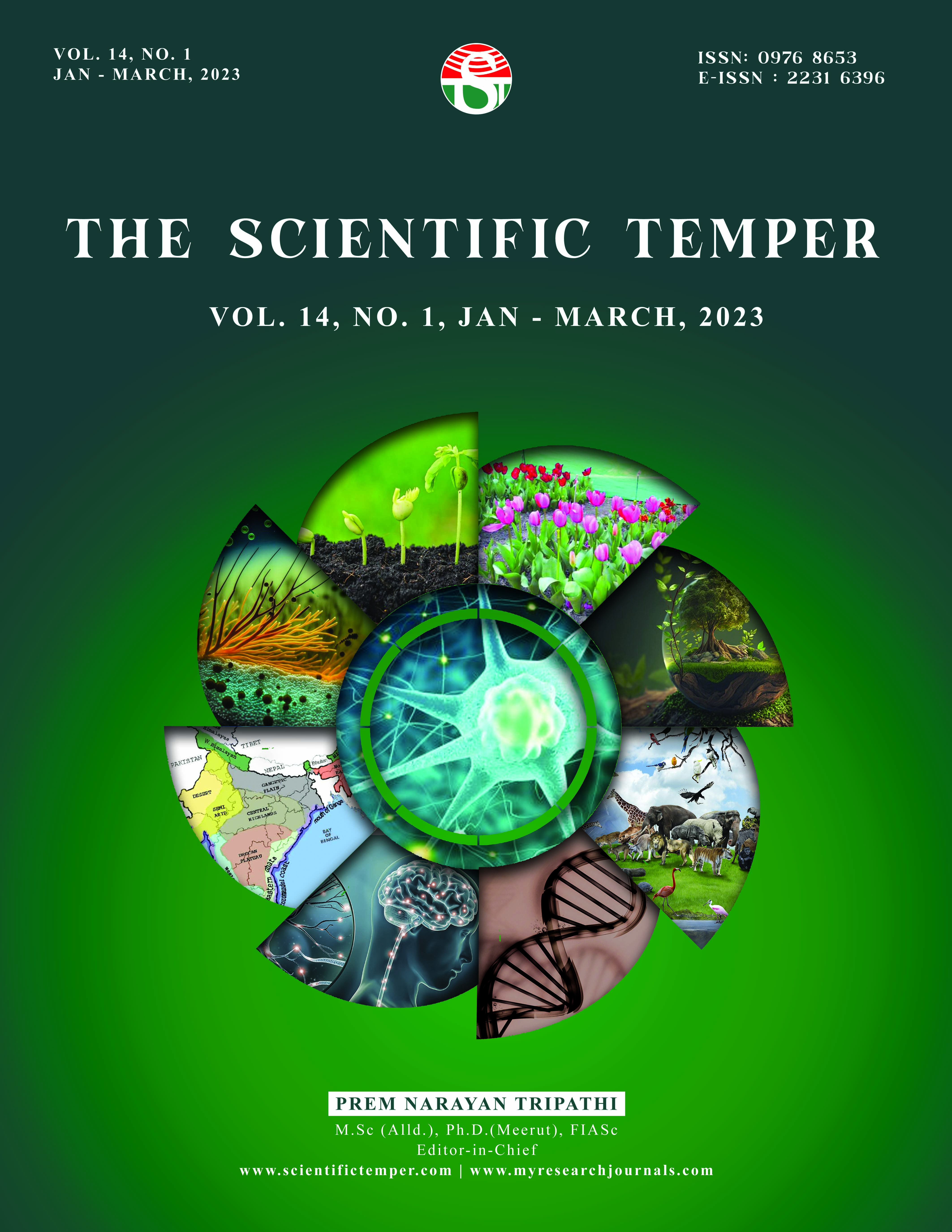Physicochemical Characterization of Vermicompost and its Effect on Acidic Soils in Ethiopia
Downloads
Published
DOI:
https://doi.org/10.58414/SCIENTIFICTEMPER.2023.14.1.06Keywords:
Acidity, Eisenia foetida, Selected soil properties, Substrates, VermicompostDimensions Badge
Issue
Section
Many parts of the Ethiopian highlands have a problem of acidity which causes the gradual reduction of soil fertility and crop productivity. There has been no research done on the effect of vermicompost (VC) individually or combined with lime and inorganic fertilizers in ameliorating the acidic soils of the country. Hence, the objective of the present study was to characterize the physicochemical properties of VC prepared from different feedstock and to evaluate the effect of VC on selected properties of acidic soil of the site. The study was conducted during 2021 at Yeferzeye kebele and cow manure (CM), enset leaf (EL), potato peels (PP), and paper waste (PW) were utilized to prepare the VC from earthworms (Eisenia fetida). A two-month incubation experiment was also conducted in the green house with four different VC rates (0, 2.5, 5 and 7.5 t ha-1). The highest value of organic carbon (21.44%) and total nitrogen (3.04%) were found in the CM whereas the highest total phosphorus (2794.8 mg kg-1 VC) was recorded from vermicompost made from PW. VC produced from PP substrates had the greatest available Potassium (7286.67 mg kg-1 VC). The highest VC rate (7.5 t ha-1) elevated the pH of the PW from 4.94 to 5.48. Similarly, the highest content of OM (3.2%) was produced in EL, (3.21%) in PP and (3.25%) in PW at the highest rate. The highest increase in total N (0.25%) was also recorded in EL at the highest rate and the lowest was recorded (0.18%) in CM and EL at the control. The available P of the soil varied from 1.78–24.33 mg kg−1 after incubation. The highest available K (1360 mg kg-1) was obtained when the rate of 7.5 t ha−1 were applied with PP compared to the control. Hence, the findings showed that applying VC to the acidic soil can improve soil fertility and increase crop nutrient availability.Abstract
How to Cite
Downloads
Similar Articles
- ARVIND MISHRA , 1SHUBHA NIGAM, CPM TRIPATHI, ARSENIC CONTAMINATION OF GROUND WATER IN ENDEMIC AREA OF UTTAR PRADESH: A CASE STUDY , The Scientific Temper: Vol. 2 No. 1&2 (2011): The Scientific Temper
- Amir Asad, Siddiqui M. Asif, Mohommad Arif, Veena Pandey, ISOLATION AND SCREENING OF XYLANASE PRODUCING ASPERGILLUS SP FROM SOIL. , The Scientific Temper: Vol. 1 No. 01 (2010): The Scientific Temper
- Ahmed Mustefa, Efficacy of coffee farmers’ cooperatives in Gimbo Woreda, Kafa Zone, Ethiopia , The Scientific Temper: Vol. 14 No. 01 (2023): The Scientific Temper
- Vijaylaxmi, Nirmala Koranga, Atal Bihari Bajpai, Physical Properties of Potyvirus on Chilli (Capsicum annuum) of Doon Valley in Uttarakhand , The Scientific Temper: Vol. 13 No. 02 (2022): The Scientific Temper
- Kowsalya Ramasamy, Thiyagarajan Krishnan, Performance analysis of RF substrate materials in ISM band antenna applications , The Scientific Temper: Vol. 14 No. 02 (2023): The Scientific Temper
- Isreal zewide, Abde S. Hajigame, Wondwosen Wondimu, Kibinesh Adimasu, Response of Bread Wheat (Triticum aestivum L.) Varieties to Blended NPSB Fertilizer Levels in Sori Saylem District, South-West Ethiopia , The Scientific Temper: Vol. 14 No. 02 (2023): The Scientific Temper
- Jasleen Kaur, Sultan Singh, Assessing the Impact of Stress on the Health and Job Performance of Employees in Indian Banks , The Scientific Temper: Vol. 14 No. 04 (2023): The Scientific Temper
- Elangovan G. Reddy, Anjana Devi V, Subedha V, Tirapathi Reddy B, Viswanathan R, A smart irrigation monitoring service using wireless sensor networks , The Scientific Temper: Vol. 14 No. 04 (2023): The Scientific Temper
- Pankaj Kumar, Ambrish Pandey, Rajendrakumar Anayath, Study of print suitability of environment-friendly plastics using flexography printing , The Scientific Temper: Vol. 15 No. 01 (2024): The Scientific Temper
- Bhoomika Singh, Defluoridation of Drinking Water in India , The Scientific Temper: Vol. 13 No. 01 (2022): The Scientific Temper
<< < 1 2 3 4 5 6 7 8 9 10 > >>
You may also start an advanced similarity search for this article.
Most read articles by the same author(s)
- Teklil Abadeye, Teshome Yitbarek, Isreal Zewide, Kibinesh Adimasu, Assessing soil fertility influenced by land use in Moche, Gurage Zone, Ethiopia , The Scientific Temper: Vol. 14 No. 01 (2023): The Scientific Temper
- Isreal Zewide, Wondwosen Wondimu, Melash Woldu, Kibnesh Admasu, Maize (Zea mays L.) Productivity as affected by different ratios of fertilizer (blended NPS) and inter row spacing at West Omo, South-West Ethiopia , The Scientific Temper: Vol. 14 No. 01 (2023): The Scientific Temper
- Isreal zewide, Abde S. Hajigame, Wondwosen Wondimu, Kibinesh Adimasu, Response of Bread Wheat (Triticum aestivum L.) Varieties to Blended NPSB Fertilizer Levels in Sori Saylem District, South-West Ethiopia , The Scientific Temper: Vol. 14 No. 02 (2023): The Scientific Temper
- Isreal Zewide, Tamiru Boni, Wondwosen Wondimu, Kibinesh Adimasu, Yield and economics of bean (Phaseolus vulgaris L.) as affected by blended NPS fertilizer rates and inter row spacing at maenitgoldia, Southwest Ethiopia , The Scientific Temper: Vol. 14 No. 02 (2023): The Scientific Temper
- Isreal Zewide, A coffee biochar-mineral NP interaction: Boon for soil health , The Scientific Temper: Vol. 15 No. 02 (2024): The Scientific Temper



